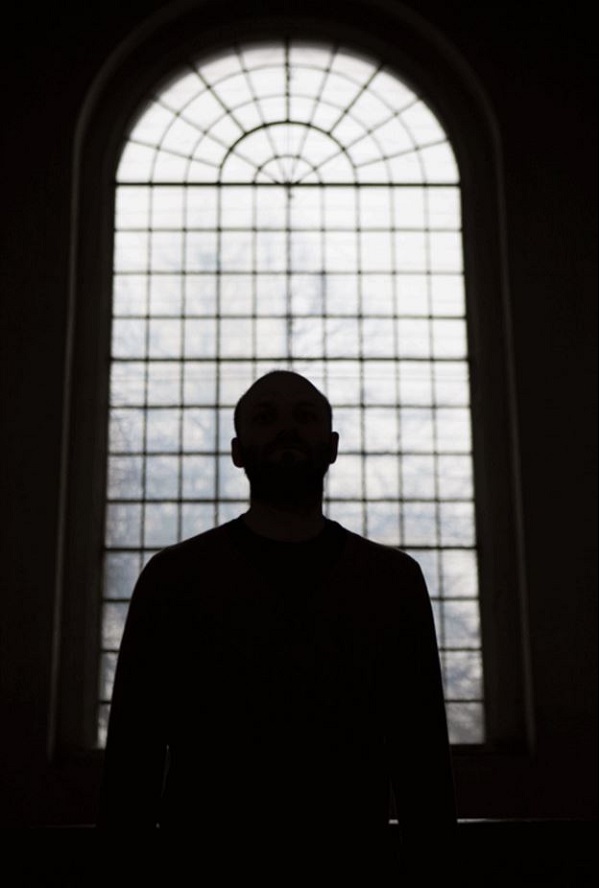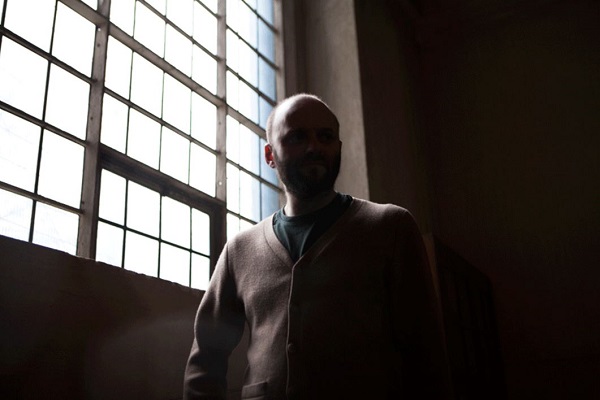
RCRD: A Conversation with Andy Stott

“This record is a balancing act. It’s delicate.” Speaking with Andy Stott about his new album Too Many Voices, it’s clear that balancing is something that he has mastered since he first emerged on Modern Love in 2005. Occupying the grey area that unites austere, mechanical experimentalism with euphonic bliss, the reason Stott is so consistently compelling is because he can straddle seemingly disparate musical worlds.
It’s this delicate poise that made his early techno variations so striking. Earning his stripes with a number of dancefloor-proof cuts that combined a tough Detroit and Chicago sound with nods towards a UK-inflected palette of garage and lurching dubstep, the Mancunian really came into his own when he stepped away from the dancefloor with 2011’s mini-album Passed Me By. It was at this point that Stott first carved out the sound that he has become universally lauded for both inside and out of the techno arena. It’s a sound that’s mechanical, earthy and beautiful in equal measure, one that is characterised by fuzzy banks of ambience clearing and reforming to frame icy vocals and thundering percussion. Gut wrenchingly dissonant but never sterile, Stott’s creations are some of the few that can truly claim to blur the boundaries between acoustic and electronic music.

The intervening years have seen Stott cement his position at the frontiers of techno. His two milestone albums since 2011, Luxury Problems and then Faith in Strangers, drew their strength from dusty analogue soundscapes reminiscent of scratchy, claustrophobic Arthur Russell cuts. Too Many Voices, however, is more heavily indebted to the hyper-saccharine unsubtlety of first wave grime music. It seems to be the first sign of another evolution in Stott’s sound: “The sound evolved because of a new synth. I felt like I was moving away from Faith in Strangers and Luxury Problems anyway, but I got this keyboard – a Korg Triton – because a friend of mine, Shlom (who runs Modern Love) had been playing me a lot of grime, in particular some old Dizzee Rascal and DJ Slimzee mixes. I can’t remember what show they were on, but they were just so rough and so raw. I was like ‘What are these sounds?’ I read into it and it’s this synth. It really defined the record – it gave it its backbone.”
“I think there’s been a shift in sound and a shift in experience”
The raw energy that propelled millennial grime is clear throughout the record, from the bubbling, crystalline staccato of ‘Butterflies’ to the murky synthetic sheen of ‘Over’. It’s much more spacious. Stott attributes part of this to learning his gear: “I think there’s been a shift in sound and a shift in experience. Going back to the boxes that I had at the time of Faith in Strangers, I was really just putting things through those at full pelt, just to see what they would do. In the space of time between that record and this record I have really learned how to tweak certain things to get what I want out of them. So now I’m not ramming everything through and getting massive signals. It’s more refined, and that’s been part of adding the space to it.”
There is still something pointedly Stott-like to Too Many Voices, though. “The material itself is a lot cleaner than what I would normally do or what I’m known for doing. Don’t get me wrong, there is distortion on the record and ‘heaviness’, but I really enjoyed using the light, super clean and almost plastic keys. And these vocals. Throughout almost every track there’s these synthetic vocals – I got really drawn into them.” Stott has previously employed the ethereal voice of his childhood piano teacher, Alison Skidmore. Almost operatic in her range, the conflict between Skidmore’s vocals and their backdrop of churning electronics provided one of the recurring points of textural interest in past albums.
The computerised choir that Skidmore’s voice has been augmented with plays a similar textural role on the aptly named Too Many Voices (Stott later tells me that there’s “no mystery behind [the album title] whatsoever… this one was a working title for the title track that stuck.”) Reminiscent of the hyperactive sugar-tronics of Oneohtrix Point Never’s Garden of Delete LP and the fourth-world futurist pop of Japan’s Yellow Magic Orchestra, the synth’s infantile sound is at once as artificial as it is strangely melancholic. Again, these choral stabs were the result of the Triton: “there’s a patch on there that’s this synthetic vocal sound. A really terrible synthetic choir. Depending on how hard you hit the key you either get an “Ooh” or an “Aah” sound. So if you play a simple chord and tap it in at different velocities, at your fingertips you instantly have so many people. You can hear that effect in the title track, in the chords and the movement of it.”

There’s an endearing honesty surrounding Stott. Not only is he a refreshingly down to earth character in a techno world that can sometimes be accused of taking itself slightly too seriously, but he is the first to admit that he’s still working and developing as an artist. He uses this to his advantage, explaining how rebuilding his studio post Faith in Strangers galvanised his creative process: “I had that naïve energy of learning a new [synth] and knowing what it does, but not using it in a refined way, just pushing it and seeing what it does when you give it full whack and it starts feeding back. I think it’s important to keep that naivety. You get more interesting results.” You again get the feeling that Stott is taking steps into a different musical space from the one which was defined by Luxury Problems. “Once you start writing again after an album, you try not to do what you’ve just done. Your material isn’t the strongest, you are finding something new – you’re exploring.”
“I think it’s important to keep that naivety. You get more interesting results”
After working in a Mercedes-Benz garage as a painter prior to taking up music full-time in 2012, Stott’s music has been shaped by the physical spaces that surround him: “when I’m sitting in the studio I’m not looking at a bigger picture. I’m just writing for that moment and I’m inspired by what I’m inspired by there and then.” Sometimes this can mean literally taking sounds from what’s around him and sampling it – his records are peppered with field recordings. Stott even takes the time to show me one such sample on Luxury Problems’ ‘Hatch the Plan’ (which is no mean feat over Skype.) “That”, he says, pointing out the unmistakable whirl and squeak of a machine at the end of the track, “that’s the machine that used to mix all the paint up.”
Critics have often drawn connections between Stott and his Manchester heritage, citing the backdrop of a post-industrial Northern city as a formative influence on the broody atmospheres that he creates. Stott sees Manchester instead as the vehicle through which he could first access the much more prominent sounds coming out of Detroit and Chicago: “I think the Manchester connection is just that that music came into there and I was able to access it that way… Manchester used to be an important city in electronic music – and it still is – and it’s because of this that I suppose I was first exposed to dance music.” His move into music full-time again shifted his sound, adding that “with Too Many Voices you can hear that I’m in a musical environment (the studio) every day. I’m not able to waltz into Mercedes-Benz with my field recorder anymore saying ‘I’m going to sample this.’ It is weird how your environment shapes your sound. I’ve never really thought about that until now.”

Our conversation repeatedly swings back to one person, and that’s Shlom Sviri. As head honcho of Manchester’s Modern Love, the label that Andy Stott has exclusively released on for the past 10 years, the pair have formed an influential friendship. “It was Shlom who first suggested maybe doing some field recordings and sampling. It was that which paved the way for Passed Me By” Stott says. “He’s the closest person to being a music producer that’s not a music producer. He could do it! I’m sure he could make a track. He’s as creative as I am.” Stott’s relationship with Sviri also reveals the collaborative nature of his writing process. “I’m open minded. If a suggestion comes along I will definitely try it. I’ll send over a track and then he’ll go through and make notes. It will get to the point where he’ll ask me to extract one particular melody and he’ll say ‘this is great, work around this.’ So I’ll then build another track around this melody that had been sat in another track. It’s been like that since the beginning, since 2005. I’ve always got 100% trust in him.”
“It’s just up to me how I get there. I’m not 100% loose, but there is definitely a lot of room to take the scenic route”
An area where Sviri has also been an important collaborative force has been in developing Andy Stott’s incredibly distinctive visual identity. Strong aesthetics have been a part of his releases since Passed Me By, and each Stott release is intrinsically linked to the monolithic black and white photograph that lies on its cover. “Shlom really takes the time to do that part of the process. From Pass Me By to Too Many Voices, there is a thread running through the [album] images. It’s in keeping. I don’t want to say a series but it is a collective really. And that’s what links everything together – the identity of the records.” The artwork for Too Many Voices’ is full of the tension within the album, with the delicate poise of the dancers seeming as unerringly mournful as their distinctly inhuman symmetry. It’s the perfect introduction to the precise, tightly controlled beauty of the Triton-fuelled landscapes within. “It’s quite light, and it’s quite spacious. And I think that’s represented in the sleeve.”
Whilst we talk, Stott’s in the midst of packing before a flight to California to play at a desert venue on a billing that includes Four Tet and Ben UFO. His live set is a reflection of his singular way of working; balancing different textures, atmospheres and influences, he can create something that’s unique. “I don’t want to play the tracks entirely, I want to feed in bits in a more interesting way. So if anyone recognises a certain part from a track off the album they’ll pick up on it, but it won’t be in the same context.” Stott’s unassuming nature means that it’s easy to forget that he sits at the bleeding edge of electronic music. His work emanates a real energy, and a sense that he enjoys experimentation and discovery. In his albums as well as his live set, is there an end destination? “It’s just up to me how I get there. I’m not 100% loose but there’s definitely a lot of room to take the scenic route.” And in the meantime, we can enjoy the journey.
Interview by Anthony Prodromou. Andy Stott was photographed by Dominic Goodman in St John's Church.
RCRD magazine is an online magazine, edited by CORD's executive creative director Dominic Goodman, which specialises in weekly interviews with music artists both new and old, established and underground. On a quarterly basis we will be collecting our favourite interviews and publishing them in a newspaper.
We’re focusing solely on original content, initially in the form of interviews and photographs, but with a view to moving into video and live events further down the line.
To date, we have interviewed a selection of artists including Andy Stott, Empress Of, Martin Rev, Jessy Lanza, Ikonika, Haelos and Throwing Shade.
You can read RCRD here.










